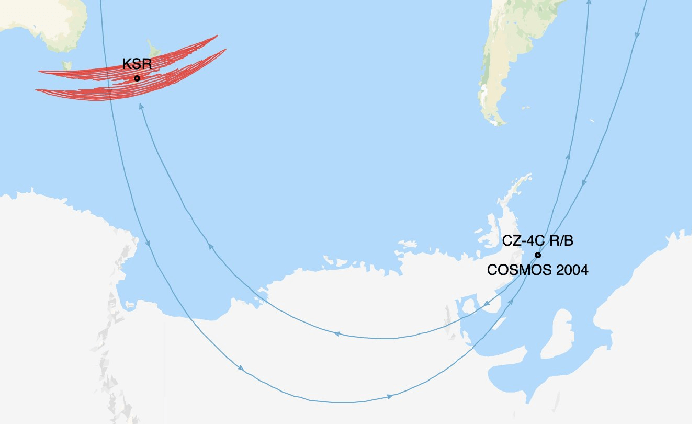A defunct Soviet (Russian) satellite and a Chinese rocket that were speeding towards each other in the space were at a “very high risk” of the collision. However, the collision between Russia and China in the outer space was fortunately avoided.
We are monitoring a very high risk conjunction between two large defunct objects in LEO. Multiple data points show miss distance <25m and Pc between 1% and 20%. Combined mass of both objects is ~2,800kg.
Object 1: 19826
Object 2: 36123
TCA: Oct 16 00:56UTC
Event altitude: 991km pic.twitter.com/6yWDx7bziw— LeoLabs, Inc. (@LeoLabs_Space) October 13, 2020
LeoLabs, a satellite tracking company said that two large defunct objects, with a combined mass of 2800Kgs, were moving towards collision in space, at a height of 991 kilometers from the surface of the earth.
Turkey Finally Tests Russian-Origin S-400 Missiles; 3 Missile Fired & Hit Targets – Reports
“This event continues to be very high risk and will likely stay this way through the time of closest approach,” LeoLabs tweeted.
2/ Current risk metrics from our most recent CDMs:
Miss distance: 12 meters (+18/-12 meters)
Probability of Collision: >10%, scaled to account for large object sizes
Relative velocity: 14.7 km/s pic.twitter.com/y44QXyhHJK— LeoLabs, Inc. (@LeoLabs_Space) October 14, 2020
The miss distance was estimated at 12 meters and the chance of collision was at 10 percent, on Wednesday. While there was no risk to anyone on earth due to the distance, however, the debris that could have been caused due to the collision can risk future collisions and even the astronauts.

By definition, space debris means defunct human-made objects in space—principally in Earth orbit—which no longer serve a useful function. Jonathan McDowell, an astronomer, estimated the amount of debris that the collision would have created would be equal to 14 tonnes of TNT.
So a more accurate estimate of the potential collision energy, in the centre of mass frame, is 60 plus or minus 5 gigajoules, or about 14 tonnes of TNT equivalent. The main uncertainty is the mass of the CZ-4C third stage, which I have at 2000 plus or minus 500 kg.
— Jonathan McDowell (@planet4589) October 15, 2020
Since both the satellite and the rocket were defunct, there was no way to control either of the two.
“If this turns into a collision, it’s probably thousands to tens of thousands of new pieces of debris that is going to cause a headache for any satellite that’s going out into upper low-Earth orbit, or even beyond,” said Dan Ceperley, the CEO of LeoLabs, according to Business Insider.
“It’s maybe a much bigger problem than a lot of people realize.”
However, LeoLabs later said there was no indication of a collision.
No indication of collision. ?
CZ-4C R/B passed over LeoLabs Kiwi Space Radar 10 minutes after TCA. Our data shows only a single object as we'd hoped, with no signs of debris.
We will follow up in the coming days on Medium with a full in-depth risk assessment of this event!
— LeoLabs, Inc. (@LeoLabs_Space) October 16, 2020
There have been growing concerns by astronomers for the increasing amount of space debris in earth’s orbit. According to the European Space Agency, there are about 128 million debris objects in orbit and about 34,000 of those objects are greater than 10 cm, as of February this year.
Per @Leolabs_space, bullet dodged. But space debris is still a big problem.
— Jonathan McDowell (@planet4589) October 16, 2020
Even the tiny debris could prove to be catastrophic for satellites as they travel at great velocities.
“The debris problem will continue to grow as more and more satellites launch to space — a trend that’s accelerating, thanks to continuing decreases in the costs of both launch and satellite development. And the problem could get out of hand, seriously threatening spaceflight and exploration activities, if we don’t start tackling it now,” wrote Space.com, citing experts.
China Ridicules Australia; Says With A Mere 1.4 Trillion Economy, It Seeks To Challenge Beijing
What’s even more worrying is that countries are now intentionally sending anti-satellite missiles which creates huge debris in space. Russia, China and the US have all launched such missiles. In 2019, India also successfully test-fired an Anti-Satellite Weapon that created about 6500 pieces of space debris.
According to NASA, two events created 70% of orbital debris.
“The deliberate destruction of the Chinese Fengyun-1C spacecraft in 2007 and the accidental collision of an American and a Russian spacecraft in 2009 alone have increased the large orbital debris population in low Earth Orbit by approximately 70%, posing greater collision risks for spacecraft operating in low Earth orbit.”




